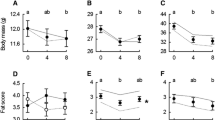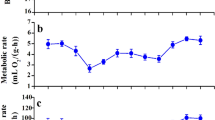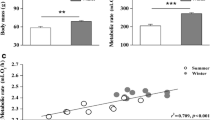Abstract
Animals with high metabolic rates are believed to have high rates of carbon and nitrogen isotopic incorporation. We hypothesized that (1) chronic exposure to cold, and hence an increase in metabolic rate, would increase the rate of isotopic incorporation of both 13C and 15N into red blood cells; and (2) that the rate of isotopic incorporation into red blood cells would be allometrically related to body mass. Two groups of sparrows were chronically exposed to either 5 or 22°C and switched from a 13C-depleted C3-plant diet to a more 13C-enriched C4-plant one. We used respirometry to estimate the resting metabolic rate \((\dot V_{\text{O}_2})\) of birds exposed chronically to our two experimental temperatures. The allometric relationship between the rate of 13C incorporation into blood and body mass was determined from published data. The \(\dot V_{\text{O}_2}\) of birds at 5°C was 1.9 times higher than that of birds at 22°C. Chronic exposure to a low temperature did not have an effect on the rate of isotopic incorporation of 15N save for a very small effect on the incorporation of 13C. The isotopic incorporation rate of 13C was 1.5 times faster than that of 15N. The fractional rate of 13C incorporation into avian blood was allometrically related to body mass with an exponent similar to −1/4. We conclude that the relationship between metabolic rate and the rate of isotopic incorporation into an animal’s tissues is indirect. It is probably mediated by protein turnover and thus more complex than previous studies have assumed.



Similar content being viewed by others
References
Bayne BL, Hawkins AJS (1997) Protein metabolism, the cost of growth, and genomic heterozygosity: experiments with the mussel Mytilus galloprovincialis Lmk. Physiol Zool 70:391–402
Bearhop S, Waldron S, Votier SC, Furness RW (2002) Factors that influence assimilation rates and fractionation of nitrogen and carbon stable isotopes in avian blood and feathers. Physiol Biochem Zool 75:451–458
Brody T (1999) Nutritional biochemistry. Academic, New York
Brown JH, West GB, Enquist BJ (2000) Scaling in biology: patterns, processes, causes, and consequences. In: Brown JH, West GB (eds) Scaling in biology. Oxford University Press, New York, pp 1–24
Dawson WR, O’Connor TP (1996) Energetic features of avian thermoregulatory responses. In: Carey C (eds) Avian energetics and nutritional ecology. Chapman and Hall, New York
Evans-Ogden LJ, Hobson KA, Lank DB (2004) Blood isotopic (δ13C and δ15N) turnover and diet-tissue fractionation factors in captive Dunlin (Calidris alpina pacifica). Auk 121:170–177
Gannes LZ, O’Brien D, Martínez del Rio C (1997) Stable isotopes in animal ecology: assumptions, caveats, and a call for laboratory experiments. Ecology 78:1271–1276
Gannes LZ, Martínez del Rio C, Koch P (1998) Natural abundance variation in stable isotopes and their uses in animal physiological ecology. Comp Biochem Physiol 119A:725–737
Haramis GM, Horde DG, Macko SA, Walker JL (2001) Stable isotope analysis of canvasback winter diet in Upper Chesapeake Bay. Auk 118:1008–1017
Hiramatsu T, Fukagawa N, Marchini J, Cortiella J, Yong-Ming Y, Chapman T, Young V (1994) Methionine and cysteine kinetics at different intakes of cysteine in healthy adult men. Am J Clin Nutr 60:525–533
Hobson KA, Bairlein F (2003) Isotopic fractionation and turnover in captive garden warblers (Sylvia borin): implications for delineating dietary and migratory associations in wild passerines. Can J Zool 81:1630–1635
Hobson KA, Clark RG (1992) Assessing avian diets using stable isotopes I: turnover of 13C in tissues. Condor 94:181–188
Hobson KA, Clark RG (1993) Turnover of 13C in cellular and plasma fractions of blood: implications for nondestructive sampling in avian dietary studies. Auk 110:638–641
Houlihan DF, Carter CG, McCarthy I (1995) Protein turnover in animals. In: Walsh PJ, Wright P (eds) Nitrogen metabolism and excretion CRC Press Boca Raton. Institute for Laboratory Animal Research. 1995. Nutrient requirements of laboratory animals. National Academy Press, Washington, pp 1–32
Klaasen M, Thums M, Hume ID (2004) Effects of diet change on carbon and nitrogen stable-isotope ratios in blood cells and plasma of the long-nosed bandicoot (Perameles nasuta). Aust J Zool 52:635–647
Lobley GE (1988) Protein turnover and energy metabolism in animals: interactions in leanness and obesity. In: Leclercq B, Whithead CC (eds) Leanness in domestic birds. Butterworths, London, pp 331–361
Lobley GE (2003) Protein turnover—what does it mean for animal production. Can J Anim Sci 83:327–340
Lotz CN, Martinez del Rio C, Nicolson SW (2003) Hummingbirds pay a high cost for a warm drink. J Comp Physiol B 173:455–462
Marsh AG, Maxson Jr RE, Manahan DT (2000) High macromolecular synthesis with low metabolic cost in Antarctic sea urchin embryos. Science 291:1950–1952
Martínez del Rio C, Wolf BO (2004) Mass balance models for animal isotopic ecology: linking diet’s stoichiometry and physiological processes with broad scale ecological patterns. In: Starck JM, Wang T (eds) Physiological and ecological adaptations to feeding in vertebrates. Science Publishers, Berlin (in press)
McWhorter T, Powers D, and Martínez del Rio C (2003) Ammonotely, nitrogen excretion and nitrogen requirements in three sympatric hummingbird species. Physiol Biochem Zool 76:731–743
O’Brien DM, Schrag DP, Martinez del Rio C (2000) Allocation to reproduction in a hawkmoth: a quantitative analysis using stable carbon isotopes. Ecology 81:2822–2831
Pearson SF, Levey DJ, Greenberg CH, and Martínez del Rio C (2003) Effects of elemental composition on the incorporation of dietary nitrogen and carbon and isotopic signatures in an omnivorous songbird. Oecologia 135:516–523
Peters RH (1983) The ecological implications of body size. Cambridge University Press, Cambridge
Phillips DL and Koch PL (2002) Incorporating concentration dependence in stable isotope mixing models. Oecologia 130:114–125
Ponsard S and Averbuch P (1999) Should growing and adult animals fed on the same diet show different d15N values? Rapid Commun Mass Sp 13:1305–1310
Post DM (2002) Using stable isotopes to estimate trophic position: models, methods, and assumptions. Ecology 83:703–718
Reeds PJ (2000) Dispensable and indispensable amino acids for humans. J Nutr 130:1835S–1840S
Sokal RK and Rohlf FJ (1995) Biometry. Freeman and Company, New York
Tieszen LL, Boutton TW, Tesdahl KG and Slade NA (1983) Fractionation and turnover of stable carbon isotopes in animal tissues: implications for δ13C analysis of diet. Oecologia 57:32–37
Voigt CC, Matt F, Michener R, and Kunz TH (2003) Low turnover rates of carbon isotopes in tissues of two nectar-feeding bat species. Jrnl Exp Biol 206:1419–1427
Waterlow JC (1968) Observations on the mechanism of adaptation to low protein intakes. Lancet 2:1091–1097
Waterlow JC (1999) The mysteries of nitrogen balance. Nut Res Rev 12:25–54
Waterlow JC, Garlick PJ and Millward DJ (1978) Protein turnover in mammalian tissues and in the whole body. Elsevier, Amsterdam
Welle S and Nair KS (1990) Relationship of resting metabolic rate to body composition and protein turnover. Am J Physiol 258:990–998
West GB, Brown JH, and Enquist BJ (1997) A general model for the origin of allometric scaling laws in biology. Science 276:122–126
Williams CC, Cummins KA, Hayek MG, Davenport GM (2001) Effects of dietary protein on whole-body protein turnover and endocrine function in young-adult and aging dogs. J Anim Sci 79:3128–3136
Wolf BO and Martínez del Rio C (2000) Use of saguaro fruit by White-winged doves: isotopic evidence of a tight ecological association. Oecologia 124:536–543
Acknowledgements
We thank Bradley Hartman Bakken for allowing us to trap sparrows on his lawn. Dan Reuss assisted us in the isotope analysis at Colorado State University. Robert Carroll provided invaluable assistance at the Animal Care Facility. We thank Blair Wolf and Merav Ben David for their critical reviews of this manuscript. We thank Annie Bakken for the artwork. This research was supported by NSF IBN-0110416 to C.M.R.
Author information
Authors and Affiliations
Corresponding author
Additional information
Communicated by Jim Ehleringer
Rights and permissions
About this article
Cite this article
Carleton, S.A., Rio, C.M.d. The effect of cold-induced increased metabolic rate on the rate of 13C and 15N incorporation in house sparrows (Passer domesticus). Oecologia 144, 226–232 (2005). https://doi.org/10.1007/s00442-005-0066-8
Received:
Accepted:
Published:
Issue Date:
DOI: https://doi.org/10.1007/s00442-005-0066-8




